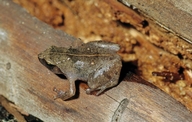|
Description
M 14 mm, F 15 mm. Tympanum about 1/2 of eye diameter. Tibiotarsal articulation reaches posterior edge of eye. Fingertips, especially on finger 3, distinctly enlarged. Finger 1 extremely reduced, but four fingers and five toes are clearly recognizable. Skin on the back smooth or slightly granular. Back grey with two black spots in the inguinal region and sometimes with a light mid-dorsal line (Glaw and Vences 2007). Distribution and Habitat
Country distribution from AmphibiaWeb's database: Madagascar
Known only from Ambohitantely (Glaw and Vences 2007) at 1500 m asl (Dallan and Raxworthy 2008), in fragmented forest (Glaw and Vences 2007). Life History, Abundance, Activity, and Special Behaviors
Habits: Active during the day in the leaf litter. Calling specimens were found on the ground, but similar calls were also heard from tree ferns, at heights of about 3 m above the ground (Glaw and Vences 2007).
Calls: Regular series of chirping notes of high frequency (Glaw and Vences 2007).
Trends and Threats
It occurs only in the Reserve Speciale d'Ambohitantely, which has little protection. This species has a tiny area of occupancy (probably less than 10 km2), with all individuals in a single sub-population. The forest is disappearing very rapidly at its only known locality due to the impacts of fire, illegal woodcutting by local people, and overgrazing by livestock. No other suitable habitat is nearby, implying that this species will go extinct unless conservation measures are put in place very soon (Dallan and Raxworthy 2008).
Possible reasons for amphibian decline General habitat alteration and loss
Habitat modification from deforestation, or logging related activities
Intensified agriculture or grazing
Comments
Taken with permission from Glaw and Vences (2007).
References
Glaw, F., and Vences, M. (2007). Field Guide to the Amphibians and Reptiles of Madagascar. Third Edition. Vences and Glaw Verlag, Köln.
Vallan, D. and Raxworthy, C. (2008). Stumpffia helenae. In: IUCN 2008. 2008 IUCN Red List of Threatened Species. www.iucnredlist.org. Downloaded on 22 April 2009.
Originally submitted by: Miguel Vences and Frank Glaw (first posted 2009-04-21)
Edited by: Kellie Whittaker (2010-07-19)Species Account Citation: AmphibiaWeb 2010 Anilany helenae <https://amphibiaweb.org/species/6400> University of California, Berkeley, CA, USA. Accessed Jul 26, 2024.
Feedback or comments about this page.
Citation: AmphibiaWeb. 2024. <https://amphibiaweb.org> University of California, Berkeley, CA, USA. Accessed 26 Jul 2024.
AmphibiaWeb's policy on data use.
| 




 Map of Life
Map of Life